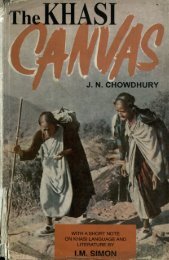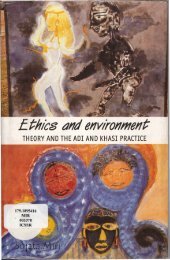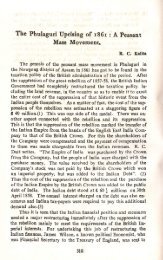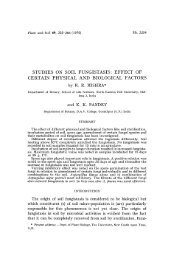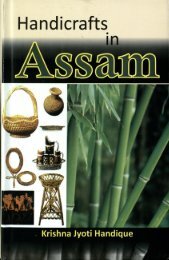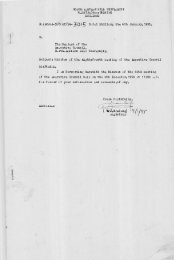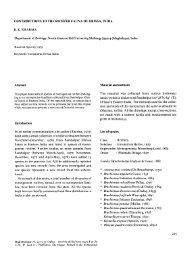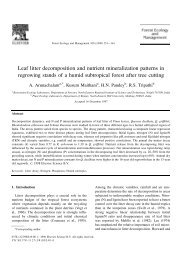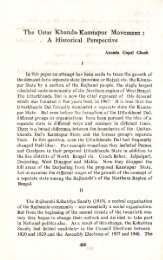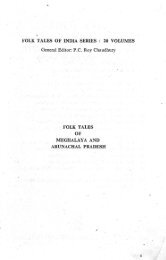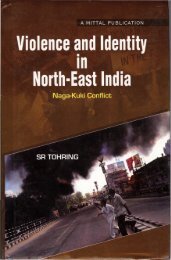Reorganisation of NE India Since 1947.pdf - DSpace@NEHU ...
Reorganisation of NE India Since 1947.pdf - DSpace@NEHU ...
Reorganisation of NE India Since 1947.pdf - DSpace@NEHU ...
You also want an ePaper? Increase the reach of your titles
YUMPU automatically turns print PDFs into web optimized ePapers that Google loves.
REORGANIZATION OF NORTH-EAST INDIA SINCE 1947
Dr. B. DaUa Ray, (b.1925) a pioneer in promoting and popularising res~arch<br />
in social sciences in the tribal areas <strong>of</strong> the North-Eastern <strong>India</strong>, is the founder-<br />
Secretary <strong>of</strong> the North- East <strong>India</strong> Council for Social Science Research. Aveteran<br />
freedom fighter and a Tamrapatra holder, Dr. Datta Ray is a former Head <strong>of</strong> the<br />
Political Science Department <strong>of</strong> St. Edrnund's College, Shillong, and has authored<br />
and edited a number <strong>of</strong> publications.<br />
S. P. Agrawal (b.1929) was Director, National Social Science Documentation<br />
Centre, ICSSR, and Member·Secretary, <strong>India</strong>n Association <strong>of</strong> Social Science<br />
Institution. He was also the Vice-Chairman <strong>of</strong> the Asia and Pacific Information<br />
Network in Social Sciences (API<strong>NE</strong>SS).ln 1988, he was awarded the degree <strong>of</strong><br />
Philosophy in Education (Honoris Causa) by International University Foundation.<br />
Presently, he is a Member, Round Table on Research in Reading, IFLA and<br />
Member, International Committee for Social Science Information and<br />
Documentation. He is also Member·<strong>of</strong> Board <strong>of</strong> Studies <strong>of</strong> National Archives <strong>of</strong><br />
<strong>India</strong> and Hindi Advisory Committee, Ministry <strong>of</strong> Coal, Government <strong>of</strong> <strong>India</strong> Born<br />
and brought up in the cradle <strong>of</strong> freedom movement which he joined at the tender<br />
age<strong>of</strong> twelve, he gained an insight into political problems and developed a sense<br />
<strong>of</strong> responsibility which bore fruit as an information scientist committed to<br />
Gandhiji's philosophy and action-plan in the field and its social concept. He has<br />
written extensively on various aspects <strong>of</strong> education, <strong>India</strong>n polity and library and<br />
information Science.
REORGANIZATION<br />
OF<br />
NORTH-EAST INDIA SINCE 1947<br />
' ..<br />
Edited by<br />
B. DATTA RAY<br />
Secretary<br />
North-East <strong>India</strong> Council for Social Science Research<br />
SHILLONG<br />
S. P. AGRAWAL<br />
Former Director<br />
National Social Science Documentation Centre. ICSsR.<br />
<strong>NE</strong>W DELHI<br />
CONCEPT PUBLISHING COMPANY, <strong>NE</strong>W DELHI-llOO59
All rights reserved. No part <strong>of</strong> this work may be reproduced, stored in a<br />
retrieval system, or transmitted, in any form or by any means, electronic,<br />
mechanical, photocopying, recording or otherwise, without the prior written<br />
permission <strong>of</strong> the copyright owners and the publishers.<br />
ISBN 81-7022-577-9 -,<br />
First Published 1996<br />
c Editors 1994<br />
B.Datta Ray (b.1925)<br />
S.P.Auawal (b.I 929)<br />
Printed and Published by<br />
Ashok Kumar Mittal<br />
Concept PublishinC Company<br />
NI5-16, Commercial Block, Mohan Garden<br />
New Delhi-1 10059 (<strong>India</strong>)<br />
Phones: 5648039, 5649024<br />
Fax: 091-{1l)-5648053<br />
E-mail: publishing@conceptpub.com
INTRODUCTION<br />
The British took over Assam in 1826 to make the eastern frontier<br />
<strong>of</strong> the British possessions secure, although the architect <strong>of</strong> the<br />
British possession <strong>of</strong> the extended north-east frontier, David<br />
Scott, initially was against the permanent occupation <strong>of</strong> Assam.<br />
But the scene completely changed with the discovery that the<br />
tea plant was a native <strong>of</strong> Assam. The realisation that the plant<br />
was genuine tea and capable <strong>of</strong> manufacture into a marketable<br />
item and later discovery <strong>of</strong> open seams <strong>of</strong> coal and presence <strong>of</strong><br />
petroleum and other minerals made Assam attractive to British<br />
capital investment in progressive measure. The initial hesitancy .<br />
vanished and Assam was finally annexed in 1838. Assam<br />
underwent rapid transformation after this and British investment<br />
increased. With the final annexation <strong>of</strong> Assam, the Government<br />
<strong>of</strong> <strong>India</strong> assumed as successor government, the paramountcy<br />
over the north-east Hills. Like the Ahoms, the Supreme<br />
Government pursued a policy <strong>of</strong> non-interference tempered by<br />
conciliation and display <strong>of</strong> force. During the period <strong>of</strong> 1826 and<br />
1874, the British authority extended over the hills bordering<br />
Assam and Barak valley.<br />
During this period, relations with the hills had been handled<br />
on an adhoc basis by the <strong>of</strong>ficials in the neighbouring areas. The<br />
degree <strong>of</strong> authority exercised by the British on becoming the<br />
paramount power had varied in different areas and in reference<br />
to different races <strong>of</strong> hillmen. The object <strong>of</strong> British policy towards<br />
the hills had been conciliation and penetration giving the northeast<br />
<strong>India</strong> a new territorial and administrative unity.<br />
The British inherited and continued the Inne Line policy from<br />
the Ahoms. This was assimilated and brought into line with their<br />
own political philosopy <strong>of</strong> broad non-intervention pursued<br />
elsewhere in <strong>India</strong> at that time. The Inner Line Regulation <strong>of</strong><br />
1873, the Scheduled Districts Act, 1874, the Government <strong>of</strong> <strong>India</strong><br />
Act, 1919, the Government <strong>of</strong> <strong>India</strong> Act, 1935 broadly unfold the<br />
British tribal policy, and administration <strong>of</strong> north-east <strong>India</strong>.<br />
""
6 Reorganization <strong>of</strong> North-East <strong>India</strong> <strong>Since</strong> 1947<br />
Under the Government <strong>of</strong> <strong>India</strong> Act, 1935, the administration<br />
<strong>of</strong> hill areas <strong>of</strong> the province <strong>of</strong> Assam were classified into Excluded<br />
and Partially Excluded Areas, Excluded Areas remaining with<br />
Governor <strong>of</strong> Assam exercising power in his discretion without<br />
ministerial advice. The initiative in all legislative and executive<br />
acts in the Partially Excluded Areas lay with the Provincial<br />
Ministers, but the Governor <strong>of</strong> Assam had a special responsibility<br />
acting in his individual judgement in this field.<br />
With the coming <strong>of</strong> the Constitution <strong>of</strong> <strong>India</strong> in 1950, the tribal<br />
areas <strong>of</strong> north-east <strong>India</strong> were placed in two parts, A and B in the<br />
Table appended to the Sixth Schedule to the Constitution. In the<br />
part A, the United Khasi and Jaintia Hills District, the Garo Hills<br />
District, the Naga Hills District, the North-Cachar Hills and the<br />
Mikir Hills District were placed. The North-East frontier Tracts<br />
including Balipara Frontirer Tract, Tirap Frontier Tract, Abor<br />
Hill and Mishmi Hills and the Naga Hills Tribal Areas were<br />
categorised in Part B . Part A areas formed the Autonomous<br />
Districts and were administered by the Government <strong>of</strong> Assam<br />
with the Autonomous District Councils established in 1952 except<br />
in Naga Hills District. The Governor <strong>of</strong> Assam continued to<br />
administer at his discretion Part B areas as Agent to the President<br />
<strong>of</strong> <strong>India</strong>. The Naga Hills were restive and refused the scheme<br />
under the Sixth Schedule to the Constitution. In 1954, after minor<br />
territorial adjustments, the North-East Frontier Tracts with Abor<br />
Hills and Mishmi Hills Districts were transformed into North-<br />
East Frontier Agency, under Ministry <strong>of</strong> External Affairs.<br />
Subsequently in 1965, the Ministry <strong>of</strong> Home Affairs took charge<br />
<strong>of</strong> it. The Lushai Hills District became Mizo District in 1954.<br />
The Tuensang Division <strong>of</strong> North-East Frontier Agency and<br />
the Naga Hills District became a new administrative unit under<br />
the Ministry <strong>of</strong> External Affairs in 1957. The Government <strong>of</strong><br />
Assam lost its authority over the Naga Hills District and the<br />
rolling back process began. In December, 1963, the State <strong>of</strong><br />
Nagaland was born. Nagaland became the trend-setter. The<br />
demands for separate political identities in the hills gathered<br />
momentum. A short lived experiment was made to stem the tide<br />
in the form <strong>of</strong> Autonomous State <strong>of</strong> Meghalaya in 1970.Meghalaya<br />
was made a full state in 1972.The North-Eastern Frontier Agency<br />
was transformed into Arunachal Pradesh and upgraded along<br />
with Mizoram into Union Territory. The Governor <strong>of</strong> Assam lost
Introduction 7<br />
his administrative control over Arunachal Pradesh. The dream<br />
<strong>of</strong> greater Assam ended thus in 1972. The princely States <strong>of</strong><br />
Manipur and Tripura which acceded to Union <strong>of</strong> <strong>India</strong> in 1949<br />
under the Instrument <strong>of</strong> Accession were initially under respective<br />
Chief Commissioners and in 1972 they became full fledged states.<br />
The Government <strong>of</strong> <strong>India</strong> Act, 1935 and the Constitution <strong>of</strong><br />
<strong>India</strong> kindled the aspirations <strong>of</strong> middle class leadership <strong>of</strong> the<br />
Brahmaputra valley for an expanded Assam. The inner<br />
contradiction <strong>of</strong> the emerging society, the emergence <strong>of</strong> new<br />
middle-classes in the Hills, ethnic and linguistic assertions, the<br />
lack <strong>of</strong> sensitivity for equitable economic development in the<br />
leadership led to the break up <strong>of</strong> Assam as it stood on the coming<br />
<strong>of</strong> Constitution <strong>of</strong> <strong>India</strong> which released new social forces all over<br />
the north-east. Insurgency for ethnic identity broke the fragile<br />
administrative unity believing that homelands would give better<br />
chance in the changing geopolitical scenario. History is a hard<br />
taskmaster. Like nature, it asserts itself. <strong>Reorganisation</strong> is a<br />
continuous process. So, further reorganisation <strong>of</strong> north-east,<br />
within the broad frame <strong>of</strong> the Union <strong>of</strong> <strong>India</strong> cannot be ruled out.<br />
B. DUTTAROY
ACKNowLEDGEMENTS<br />
The papers included in this volume were presented to a Seminar<br />
on Reorganization <strong>of</strong> North-East <strong>India</strong> since 1947 organised<br />
by North-East <strong>India</strong> Council for Social Science Research,<br />
Shillong, in February 1993. The basic perimeter <strong>of</strong> the seminar<br />
was framed by Pr<strong>of</strong>essor Imdad Hussain <strong>of</strong> the Department <strong>of</strong><br />
History, North Eastern Hill University. Pr<strong>of</strong>essor B. Pakem, Vice-<br />
Chancellor, North Eastern Hill University not only inaugurated<br />
the seminar with an exposition <strong>of</strong> the basic issues <strong>of</strong> North-<br />
East <strong>India</strong> reorganisation but was a source <strong>of</strong> academic inspiration<br />
for this work.<br />
We remain very grateful to the <strong>India</strong>n Council <strong>of</strong> Historical<br />
Research, <strong>India</strong>n Council <strong>of</strong> Social Science Research, New Delhi,<br />
North Eastern Council and Government <strong>of</strong> Mizoram for giving<br />
us generous support to undertake this study.<br />
We wish to record our appreciation <strong>of</strong> the services <strong>of</strong> Mr.<br />
Rajarishi Roy, a journalist <strong>of</strong> Calcutta, who read the manuscript<br />
and <strong>of</strong> Mr. H.KGupta who gave me a strong secretarial<br />
support in the preparation <strong>of</strong> this volume.<br />
. To Mr. Ashok Kumar Mittal <strong>of</strong> the Concept Publishing Company,<br />
New Delhi, we owe a debt <strong>of</strong> gratitude for agreeing to<br />
publish this volume expeditiously.<br />
B.DATTARAY<br />
S. P. AGRAWAL
Introduction<br />
Acknowledgement<br />
List <strong>of</strong> Contributors<br />
CONTENTS<br />
HISTORICAL BACKGROUND<br />
11 Assam: Unification and Roots <strong>of</strong> Division 15<br />
-Imdad Hussain<br />
2./ The Future <strong>of</strong> the Hills <strong>of</strong> North-East <strong>India</strong><br />
1928-1947: Some British Views 24<br />
-David R. Syiemlieh<br />
PERSPECTIVE<br />
3. The Issues <strong>of</strong> State <strong>Reorganisation</strong>:<br />
Some Reflections<br />
-A.C. Talukdar<br />
37<br />
4. Citizen's Problem, State Response:<br />
Crisis <strong>of</strong> Policy in North-East<br />
-S.N.Ali<br />
<strong>India</strong> 46<br />
5 Constitutional Developments in North-East <strong>India</strong><br />
since 1947 57<br />
-S.K. Agnihotri<br />
6. Issues <strong>of</strong> <strong>Reorganisation</strong>s in North-East <strong>India</strong> 93<br />
-Sucheta Sen Choudhuri & Sarit Choudhuri<br />
7. Some Reflections on the <strong>Reorganisation</strong> <strong>of</strong><br />
North-East <strong>India</strong> 101<br />
y.<br />
-Sukhendu Mazumdar<br />
Ethnic Assertion and <strong>Reorganisation</strong> <strong>of</strong> Assam. 106<br />
-,<br />
J<br />
-Prafulla Misra<br />
The State and the Middle Class: The Case <strong>of</strong><br />
Assam (1979-90) 114<br />
~<br />
-Samir Kumar Das<br />
Prospects for Ethnic <strong>Reorganisation</strong> 128<br />
-B. B. Goswami<br />
5<br />
8<br />
12
10<br />
, 18.<br />
.><br />
~<br />
23.<br />
Reorganization <strong>of</strong> North-East <strong>India</strong> <strong>Since</strong> 1947<br />
11. <strong>Reorganisation</strong> <strong>of</strong> North-East <strong>India</strong>:<br />
APoint <strong>of</strong> Economic Viability 138<br />
-R. P. Bhattacharjee<br />
12. Deorganisation <strong>of</strong> Assamafter Independence 145<br />
-Nitendra Nath Das<br />
13. <strong>Reorganisation</strong> <strong>of</strong> North-East <strong>India</strong> 155<br />
-Po C.Biswas<br />
14. Balkanisation<strong>of</strong> North-East <strong>India</strong>:<br />
ATentative Hypothesis 168<br />
-BimanKar<br />
15. Costsand Benefits <strong>of</strong> <strong>Reorganisation</strong>: The case <strong>of</strong><br />
North-East <strong>India</strong> since Independence 171<br />
-Archana Sharma<br />
17.<br />
19.<br />
21.<br />
22.<br />
MICROSTUDIES<br />
<strong>Reorganisation</strong> and the Economic Problems <strong>of</strong> the<br />
Border Areas <strong>of</strong> Jainta Hills 177<br />
-L. S. Gassah<br />
Tribal Problems: A <strong>Reorganisation</strong>al<br />
Mattar <strong>of</strong> Assam 184<br />
-Jagdish Kalita<br />
The <strong>Reorganisation</strong> <strong>of</strong> Assamand the Bodo<br />
Movement 198<br />
-So K. Mukherjee<br />
Settlement on Bodoland :AFew Points to Ponder 205<br />
-P.S.Datta<br />
<strong>Reorganisation</strong> <strong>of</strong> the HillAreas <strong>of</strong> Assam:<br />
AStudy <strong>of</strong> Karbi AnglongDistrict 209<br />
-R. P. Athparia<br />
Tribal Policyand Constitutional<br />
Development <strong>of</strong> Arunachal Pradesh 215<br />
-J.N. Chowdhury<br />
<strong>Reorganisation</strong> <strong>of</strong> North-East <strong>India</strong>: Process,<br />
Problems and Prospects (Ananalysis in the<br />
context <strong>of</strong> Arunachal Pradesh) 232<br />
--M. C.Behera<br />
Politicaland Constitutional Development in<br />
Nagaland 241<br />
-R.P.Singh
Contents 11<br />
24. Territorial Issues and Manipur 251<br />
-Asok Kuinar Ray<br />
25 <strong>Reorganisation</strong> <strong>of</strong> Mizoram since Independence 260<br />
-M. M. Das, N. N. Sengupta, Mrinmayi Banerjee<br />
26/ <strong>Reorganisation</strong> <strong>of</strong> North-East <strong>India</strong>:AStudy<br />
<strong>of</strong> Mizoram 268<br />
-R.N. Prasad<br />
27. Concept<strong>of</strong> Smaller States and the Pace <strong>of</strong><br />
Development: ACase <strong>of</strong> Mizoram 284<br />
~S. S.Mishra<br />
28. <strong>Reorganisation</strong> Question <strong>of</strong> Tripura (1949-62):<br />
Reactions <strong>of</strong> Different PoliticalParties 294<br />
-Mahadev Chakravarti<br />
29. Tripura in Transition <strong>of</strong> Political<br />
<strong>Reorganisation</strong> <strong>Since</strong> 1947 308<br />
-Jagat Jyoti Roy<br />
Appendix<br />
Report <strong>of</strong> the Seminar 319<br />
-A.K.Neog<br />
Bibliography<br />
Index<br />
...<br />
331<br />
433
LIST OF CONTRmUTORS<br />
S. K. Agnihotri- Scholar, Meghalaya House, New Delhi<br />
S. N. AIi- Deptt. <strong>of</strong> Political Science, Arunachal University, Itanagar<br />
R. P. Athparia - Anthropological Survey <strong>of</strong> <strong>India</strong>, Shillong<br />
Mrinmayi Banerjee- Anthropological Survey <strong>of</strong> <strong>India</strong>, Shillong<br />
M. C. Behera - Zero, Arunachal Pradesh.<br />
R. P. Bhattacharjee- Economic & Statistical Deptt, Arunachal Pradesh,Itanagar<br />
BimanKar-Deptt. <strong>of</strong> Economics, Gauhati University, Guwahati<br />
P. C. Biswas- Scholar, Calcutta<br />
Mahadev Chakravarti - Deptt. <strong>of</strong> History, Tripura University Agartala<br />
Sucheta Sen Choudhuri - Anthropological Survey <strong>of</strong> <strong>India</strong>, Shillong<br />
Sarit Choudhuri - Anthropological Survey <strong>of</strong> <strong>India</strong>, Shillong<br />
J. N. Chowdhury - Scholar, Shillong<br />
M. M. Das - Anthropological Survey <strong>of</strong> <strong>India</strong>, Shillong.<br />
Nltendra N ath Das - Scholar, Sibsagar, Assam<br />
Samir Kumar Das- Deptt. <strong>of</strong> Political Science, Calcutta University, Calcutta<br />
P. S. Datta - La! Bahadur Shastri National Academy <strong>of</strong> Administration, Mussurie,<br />
U.P. .<br />
L. S. Gassah - Deptt. <strong>of</strong> Political Science, North Eastern Hill University, Shillong<br />
B. B. Goswaml- Scholar, Lucknow<br />
Imdad Hussaln - Deptt. <strong>of</strong> History, North-Eastern Hill University, Shillong<br />
Jagdish Kalita - Barama College, Barama, Assam<br />
Sukhendu Mazumdar- Scholar.Assam Rifles, 99 A.P.O.<br />
Prafulla Mlsra - Shillong Observer, Shillong<br />
S. S. Mlshra - Anthropological Survey <strong>of</strong> <strong>India</strong>, Ranchi, Bihar<br />
S. K. Mukherjee - Anthropological Survey <strong>of</strong> <strong>India</strong>, Shillong<br />
A. K. Neog - National Commission <strong>of</strong> Scheduled Castes and Scheduled Tribes,<br />
Shillong<br />
R.N.Prasad-Deptt<strong>of</strong>PublicAdministration,NorthEasternHillUniversity,Aizawl,<br />
Mizoram<br />
Asok Kumar Ray - Presidency College, Mothung, Manipur.<br />
JagatJyoti Roy - Scholar, Tripura Darpan, Agartala<br />
N .N. Sengupta - An thropological Survey <strong>of</strong> <strong>India</strong>, Shillong<br />
Archana Sharma - Deptt. <strong>of</strong> Economics, Gauhati University, Guwahati<br />
R. P. Slngh - Deptt. <strong>of</strong> Earth Science, Manipur University, Imphal<br />
D. R. Sylemlieh- Deptt. <strong>of</strong> History, North-Eastern Hill University, Shillong<br />
A. C. Talukdar- Deptt. <strong>of</strong> Political Science, Arunachal University, Itanagar
I'<br />
No region in <strong>India</strong> has undergone such fragmentation<br />
as North-Ea·st has in the four decades<br />
after independence. What remains <strong>of</strong> the old<br />
province <strong>of</strong> Assam after the last reorganisation<br />
in 1972 are virtually the districts <strong>of</strong> the<br />
Brahmaputra and barak valleys where British<br />
rule in the north-east began after the first Anglo<br />
Burmese War (1824-26). The hill regions that<br />
were brought under the administrative control<br />
<strong>of</strong> Assam as the eastern frontier <strong>of</strong> the empire<br />
extended, now formed as separate states. While<br />
the process <strong>of</strong> expansion and integration was<br />
spread over a century, the disintegration and<br />
territorial reorganisation has occurred within a<br />
relatively short time.<br />
The volume is planned to go into the historical<br />
background <strong>of</strong> the problem with special<br />
reference to the fragile nature <strong>of</strong> the administrative<br />
unity given to the erstwhile province <strong>of</strong><br />
Assam by the British; the partition at Independence<br />
and the question <strong>of</strong> ethnic identity including<br />
the role <strong>of</strong> language and the demand for<br />
reorganisation. It further examines the consequences<br />
<strong>of</strong> partition and reorganisation particularly<br />
on the social and economic developmental<br />
process in the region and the political<br />
fall-out.<br />
Rs.600<br />
f,<br />
Dr. B. Datta Ray,(b.1925) a pioneer in promoting.<br />
and popularising research in social sciences in the<br />
tribal areas <strong>of</strong> the North-Eastern <strong>India</strong>, is the<br />
founder-Secretary <strong>of</strong> the North-East <strong>India</strong> Council<br />
for SocialScience Research. A veteran freedom<br />
fighter and a Tamrapatra holder, Dr. Datta Ray is<br />
a former Head <strong>of</strong> the Political Science Department<br />
<strong>of</strong> St. Edmund's College, Shillong, and has authored<br />
and edited a number <strong>of</strong> publications.<br />
S. P. Agrawal( b.1929) was Director, National Social<br />
Science Documentation Centre, ICSSR: and<br />
Member-Secretary, <strong>India</strong>n Association <strong>of</strong> Social<br />
Science Institution. He was also the Vice-Chairman<br />
<strong>of</strong> the Asia and Pacific Information Network in<br />
Social Sciences (API<strong>NE</strong>SS). In 1988,he was awarded<br />
the degree <strong>of</strong> Philosophy in Education (Honoris<br />
Causa) by International University Foundation.<br />
Presently, he is a Member, Round Table on<br />
Research in Reading, IFLA and Member,<br />
International Committee for Social Science<br />
Information and Documentation. He is also Member<br />
<strong>of</strong> Board <strong>of</strong> Studies <strong>of</strong> National Archives <strong>of</strong> <strong>India</strong><br />
and Hindi Advisory Committee, Ministry <strong>of</strong> Coal,<br />
Government <strong>of</strong> <strong>India</strong>. Born and brought up in the<br />
cradle <strong>of</strong> freedom movemen t which he joined at the<br />
tender age <strong>of</strong> twelve, he gained an insight into<br />
political problems and developed a sense <strong>of</strong><br />
responsibility which bore Fruit as an information<br />
scientist committed to Gandhiji's philosophy and<br />
action-plan in the field and its social concept. He has<br />
written extensively on various aspects <strong>of</strong> education,<br />
<strong>India</strong>n polity-and library and information Science.<br />
ISBN 81-7022-577·9
OTHER BOOKS OF INTEREST<br />
Descriptive Account <strong>of</strong> Assam (A): With a Sketch <strong>of</strong> the Local<br />
Geography ~.<br />
- William Robinson Rs. 100<br />
Development <strong>of</strong> Administration in Assam: With Social Reference<br />
to Land Revenue, Justice and Police 1874-1920<br />
- M.1. Bose Rs. 125<br />
British Policy in North-East Frontier Agency<br />
- ML Bose Rs. 90<br />
Historical and Constitutional Documents <strong>of</strong> North Eastern<br />
<strong>India</strong> 1824-1973<br />
- ML Bose Rs. 90<br />
Social History <strong>of</strong> Assam<br />
- ML Bose Rs. 90<br />
<strong>India</strong>n Administrative Year Book 1990<br />
- Shriram Maheshwari Rs. 500<br />
<strong>India</strong>n Polity: The System <strong>of</strong> Administration in <strong>India</strong> (A new<br />
Foreword / Pr<strong>of</strong>. S.R. Maheshwari)<br />
- Sir George Chesncy Rs. 200<br />
Conflict and Tension in Tribal Society<br />
- S.P. Sinha Rs.550<br />
Ethnic Identity .and National Integration<br />
- Ali Ashraf Rs. 300<br />
Tribal Ethnography, Customary Law and Change<br />
- K.S. Singh Rs. 600<br />
Cable: CONPUBCO Ph: 5648039,5649024<br />
CONCEPT PUBLISIDNG GOMPANY<br />
A/l5-16, Commercial Block, Mohan Garden:<br />
New Delhi-I I0059 (<strong>India</strong>)<br />
Show Room Phone: 3272187<br />
4788123, Ansari Road, Daryaganj, <strong>NE</strong>W DELHI-l 10002 -<br />
1&<br />
. 1· ,



